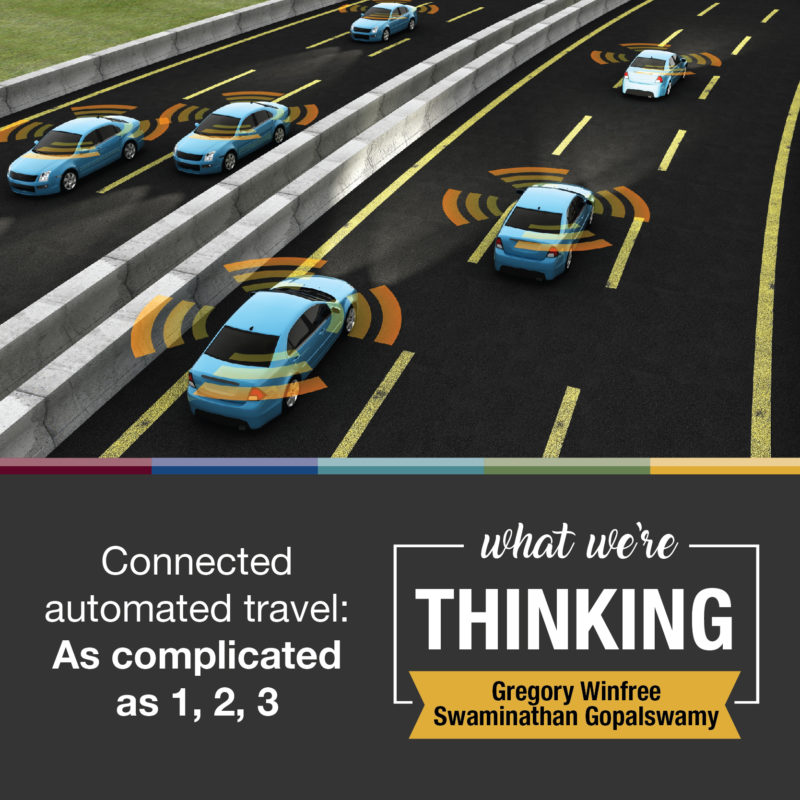 By Gregory Winfree and Swaminathan Gopalswamy
By Gregory Winfree and Swaminathan Gopalswamy
Self-driving cars will change life as we know it; no question there. But they’re only a start — just as personal computers were.
Think back to when George H.W. Bush was in the White House and gasoline cost about a dollar a gallon. Office and home desktop computers were easing the vital functions of the day: word processing, data analysis and accounting.
Then came the Internet. Suddenly, information created on those PCs held more value because it could be shared quickly and extensively. Through this connectivity, desktop computing demonstrated meaningful utility.
We’re in a similar boat today, since (so far) self-driving cars operate as conventional cars do, independent of other vehicles. To realize their abundant promise, though, automated vehicles need to be connected — not only to each other, but also to the infrastructure on which they move about. There are three steps we need to take, with self-driving autos being only the first.
Connecting with other cars
Step 2 involves getting those self-driving cars to communicate with other cars, sharing vital safety messages such as blind spot warnings, and alerts for red-light runners and approaching emergency vehicles. Enabling cars to talk to each other can prevent up to 80 percent of the crashes that don’t involve an impaired driver.
Beginning in 2021, Toyota and Lexus will include systems on their cars to enable those signals by using dedicated short range communication, or DSRC. That big step follows General Motors’ move to employ DSRC on its 2017 Cadillac CTS and Mercedes deployed it in its E- and S-class sedans in 2018.
Connected/automated vehicle technology can also help us manage the vehicular potpourri we can expect before self-driving cars become ubiquitous. There are 253 million cars on U.S. roads today, and the average vehicle age is 11.4 years. Lots of people keep their cars even longer than that. It will take at least 20 years for the existing fleet to turn over. And there will always be those Model Ts and mid-20th century muscle cars comingling with cars that don’t have steering wheels. That’s a virtual mosh pit of vehicles, and connected/automated technology can help to manage it straightforwardly.
Once cars can converse and cooperate with each other, all that remains is extending the same connection to cars and what surrounds them.
Infrastructure connection
Step 3 calls for linking vehicles to the infrastructure through sensors in and along the road, along with the traffic signs, traffic signals, and lane markings that augment the driving environment.
Imagine driving your car onto a connected highway. The highway asks you whether you wish to be driven autonomously, and if so, you provide information for your trip. The highway then takes over. Once the trip is complete, the highway tells you it’s ready to return control of the car to you. If you’re ready, fine. If you’re not ready (if you’re asleep, for instance), the highway parks your car nearby in a safe space, where it will wait until you’ve finished your nap and you’re ready to resume traveling.
That dream — infrastructure-enabled autonomy — is within reach. But realizing it won’t be easy, and it won’t be cheap. The job of developing transportation infrastructure has historically rested with government agencies. Can cash-strapped governments handle the additional cost of sensor installation on top of routine road maintenance burdens? Or will this step require a new model of collaboration between governments, automakers, and other players?
Off to a good start
To know that we can build a car that can safely and reliably drive itself, relieving us of the tiring and sometimes dangerous chore of vehicle operation, is nothing short of astonishing. A genuine reinvention of our daily mobility experience, however, requires all three of these transformational steps. In some ways, it’s looking like step one might be the easiest of the three.
In our personal computing experience of 25 years ago, we could hardly imagine the degree of connection (especially without wires) that we would one day enjoy. Now, we can hardly imagine a single day without it. Not so many years from now, we’ll likely be saying the same thing about connected travel — but only if we get things right on all three steps.
Gregory Winfree is the agency director of the Texas A&M Transportation Institute and a former U.S. assistant secretary of transportation. Swaminathan Gopalswamy is a senior research scientist at TTI and professor of practice in the Department of Mechanical Engineering at Texas A&M.
This article was originally published in the Automotive News, January 7, 2019.